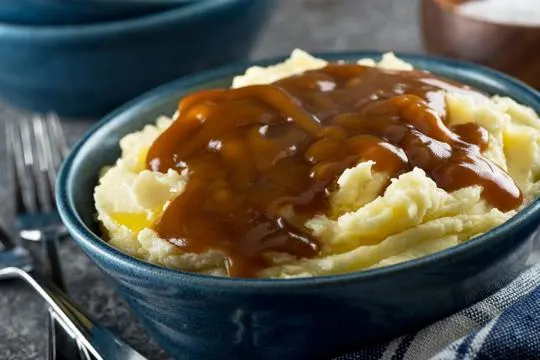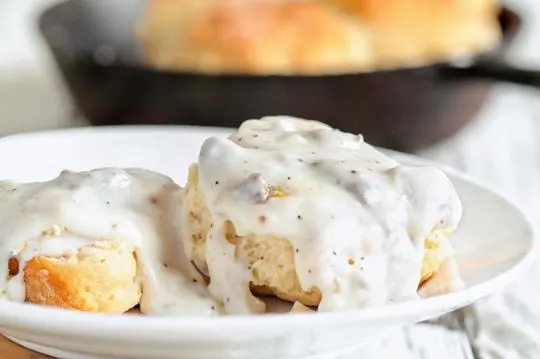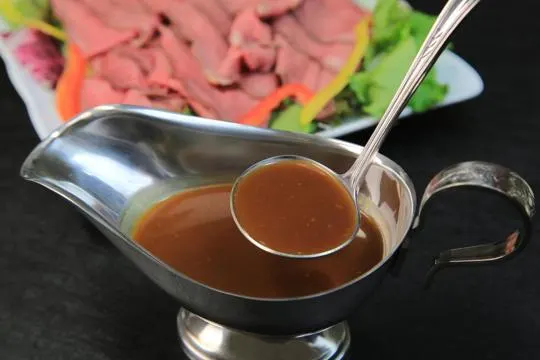Summary of key points
The main difference between brown gravy and white gravy is in the type of broth or stock used. Brown gravy is typically made with beef broth, while white gravy uses chicken or vegetable broth.
This distinction affects the color and flavor profile, with brown gravy having a richer and more savory taste, while white gravy tends to be milder and creamier.
In terms of texture, brown gravy is often thicker and smoother due to the addition of flour or cornstarch, while white gravy may have a thinner consistency.
Both types of gravy are commonly used in traditional American comfort foods such as biscuits and gravy or over mashed potatoes and meat.
Gravy: it’s more than just a sauce; it’s a divide. Brown or white, that’s the question.
We all have our favorites.
Brown gravy, rich and made from meat drippings, teams up with roasts and mashed potatoes.
White gravy, on the other hand, creamy and often peppered, belongs on biscuits.
I remember my grandma, apron on, commanding the kitchen, gravy boat in hand. She made both, claimed neither.
Our household? Divided. Mom’s for white, dad’s for brown. Dinner was always a diplomatic affair.
This is our deep, delicious dig into what sets them apart.
What is Brown Gravy?

Brown Gravy is a sauce that packs a punch.
It’s made from the drippings of roasted meats and is known for its dark color and earthy flavor.
To get this deliciousness, deglazing is key.
This process releases the flavorful bits stuck to the pan with liquid, like broth or wine.
Flour or cornstarch is then added to thicken the gravy and give it a smooth, velvety texture.
Brown Gravy is an incredibly versatile sauce.
It can be used on mashed potatoes, roasted vegetables, and juicy steaks.
Add it to any dish, and its robust taste will take it to the next level.
Plus, it’s a staple in many cuisines around the world.
White gravy and brown gravy are quite different.
White gravy is usually creamy and mild.
Brown gravy, on the other hand, offers a bolder flavor that pairs perfectly with meat dishes.
It has a savory umami taste that’s hard to beat.
Plus, chefs often add their own twists to brown gravy.
Thyme, rosemary, and garlic are all great additions.
These aromatic spices bring a delightful complexity to the flavor profile.
What is White Gravy?

White gravy, also known as country gravy, is a popular sauce.
It’s made from pan drippings, usually from cooking meats such as chicken or sausage.
Flour and milk thicken it, creating a creamy texture and savory taste.
Biscuits, fried chicken, and mashed potatoes love this beloved accompaniment.
White gravy is distinct from brown gravy.
Brown gravy uses the meat drippings plus beef stock or broth for flavor.
White gravy only uses pan drippings, so it’s lighter-colored and milder.
You can spice up white gravy with seasonings like black pepper, garlic powder, or onion powder.
Or, you can customize it by adding mushrooms or herbs.
White gravy is versatile.
It brings creaminess and richness to dishes.
It pairs with classic southern favorites, or can be used as a base for other flavors.
Any meal will be elevated by this delicious sauce.
Differences Between Brown Gravy and White Gravy

Brown gravy and white gravy are separate sauces.
They are mainly used in various cuisines. The main difference? Ingredients and flavors.
Brown gravy is made by browning meat or veg, then adding stock.
Thickening it with flour or cornstarch gives it a dark color and a savory taste.
White gravy is made with milk or cream.
It’s thickened with flour or a roux. A roux is fat and flour cooked together.
White gravy has a creamy texture and a milder flavor.
Brown gravy is usually served with meats.
White gravy is served with biscuits or fried food.
Each type of gravy has its own unique characteristics.
Enhancing the flavors of different dishes in its own way.
Color and Appearance
Brown gravy and white gravy present a delightful visual contrast.
Brown gravy has a deep, rich color due to caramelized meat drippings or stock.
White gravy is creamy and pale, made with milk or cream.
Their color reflects the flavor profiles and ingredients used in each.
Brown gravy has a savory umami taste from the browning process.
White gravy is milder, with a smooth, velvety texture.
Brown gravy may include onions, mushrooms or herbs for depth.
White gravy may have spices like black pepper or paprika to enhance its flavor and consistency.
Ingredients Used
Brown and white gravies bring different flavors and textures to the table.
Brown gravy is made with meat drippings or stock, giving it a savory taste.
The base is usually beef or chicken broth, with onions, garlic, Worcestershire sauce, and herbs added for extra flavor.
The end result is a dark brown sauce perfect for roasted meats, mashed potatoes, or even poured over biscuits.
White gravy has a creamy and velvety texture, made with milk or cream as a base.
The main ingredient is flour, to thicken the sauce.
Butter, salt, pepper, and even sausage drippings can be added for flavor.
The final sauce is smooth and luscious, perfect with biscuits and gravy or country fried steak.
Mixing brown and white gravies can create layers of flavor.
For example, add a spoonful of white gravy to a beef stew with brown gravy for a creamy richness.
Flavor and Taste
Brown gravy and white gravy have distinct tastes.
Brown gravy has a savory, umami flavor boosted by the caramelization of meat juices.
It’s hearty and pairs well with meats like beef or lamb.
White gravy has a lighter, creamier taste. It’s made from butter, flour, milk or cream, and seasonings.
It has a smooth texture and a mild flavor. Ingredients in brown gravy include beef or poultry stock, onions, garlic, and spices.
These add to its richness. White gravy just has butter, flour, milk or cream, and salt and pepper.
Brown gravy is great for heartier dishes like pot roast.
White gravy complements comfort foods, such as biscuits or mashed potatoes.
Both types of gravy offer culinary versatility.
Uses in Cooking
Cooking with brown and white gravies both have distinct purposes.
Brown gravy is great with roast beef and mashed potatoes, bringing a savory taste.
Southern food typically uses white gravy, like with biscuits and sausage gravy.
Brown gravy has a deep and hearty flavor while white gravy adds a creamy and comforting touch.
These special flavors make each type of gravy a unique and delightful addition to any meal.
Similarities Between Brown Gravy and White Gravy

Brown and white gravies have some common elements.
Both are made with fat, like butter or oil, plus flour to make a roux.
This mix is cooked until it’s the right shade.
Then, while stirring, broth or stock is added to make a thick, tasty sauce.
Salt and pepper are often added for seasoning.
There might be slight differences in the herbs and flavors used, but the process is the same for both.
These gravies can usually be used interchangeably.
Brown or white, they bring out the flavor and texture of any dish.
Cover meats? Pour over biscuits? Both will do the job. But, they’re still different.
Brown gravy is usually made with meat drippings or broth, which gives it a strong flavor that goes well with red meats like beef or lamb.
White gravy is usually made with milk or cream, which makes it creamy and smooth.
Perfect for fried chicken or mashed potatoes.
At the end of the day, it’s all about personal preference and what dish you’re making.
Brown or white, both offer great flavors.
So why not try them both and see which one pleases your palate?
How to Make Brown Gravy and White Gravy
Make brown and white gravy with different techniques and ingredients.
Brown gravy involves browning flour in fat before liquid, while white gravy requires cooking flour in fat then adding milk.
Here’s a guide:
For brown gravy:
- Heat skillet on medium heat, melt fat like butter or oil.
- Add equal amount of flour then whisk till a smooth paste.
- Whisk over medium heat for several minutes until golden brown.
- Slowly pour in broth, whisking till desired consistency.
For white gravy:
- Melt fat in skillet over medium heat.
- Add flour then whisk till combined.
- Gradually pour in milk while whisking.
- Cook over medium heat, stirring, until creamy.
You can experiment with flavors by adding herbs, spices or meat drippings.
Brown gravy has a savory flavor, great with roasted meats or mashed potatoes.
White gravy has a creamy, mild taste that complements comfort foods like biscuits and fried chicken.
Enjoy homemade gravies and elevate your meals.
Popular Dishes that Use Brown Gravy and White Gravy
Brown and white gravy both have a place in the culinary world.
Brown gravy is great for savory dishes such as pot roast, meatloaf, and mashed potatoes.
Its rich flavor pairs well with comfort foods.
White gravy is usually found in dishes like biscuits and gravy, chicken fried steak, and country-style breakfasts.
Its creamy texture and mild taste make it perfect for Southern favorites.
Brown gravy gets its dark color from beef drippings, caramelized onions, or mushrooms.
Its flavor is enhanced by these ingredients.
White gravy is made from a roux of flour cooked in fat or butter mixed with milk or cream.
This creates a creamy sauce that’s smooth and velvety.
Certain dishes traditionally call for either brown or white gravy due to the flavors they bring out.
Brown gravy pairs well with roasted meats like beef or pork.
White gravy’s mild taste goes with lighter meats like chicken or turkey without overpowering them.
Conclusion
After evaluating both white and brown gravy, it is clear that they have several differences that set them apart.
Brown gravy stands out for its heartiness, smoky flavor, and rich color.
White gravy has become popular for its creaminess and use as a savory sauce or topping.
Whether you prefer one over the other largely comes down to personal culinary preferences.
Overall, both types of gravy are delicious additions to a variety of meals and can lend comfort in times of physical or emotional hardship.
Regardless of which type of gravy you gravitate towards, all can agree that these two necessary ingredients are key staples when it comes to home cooking and filling our belly’s with much-needed sustenance.
Now, why not get creative in the kitchen and experiment with different flavors by combining brown and white gravy together? The possibilities seem endless.

Leave a comment